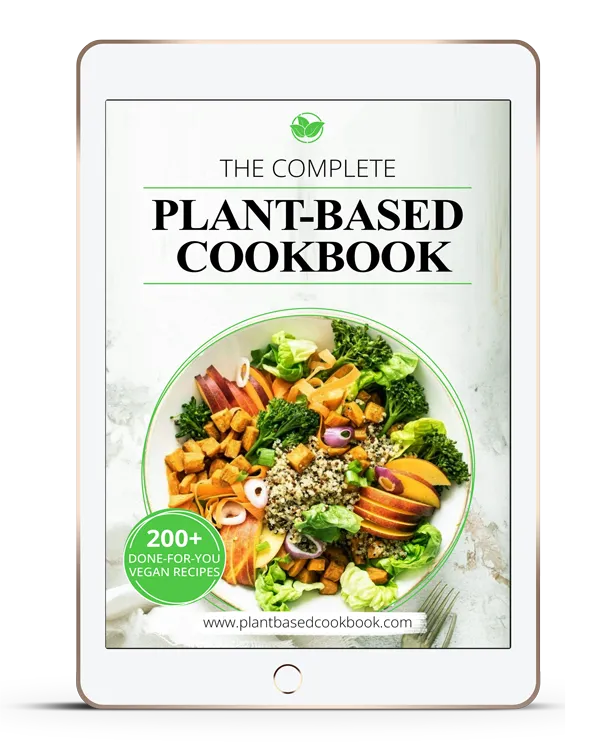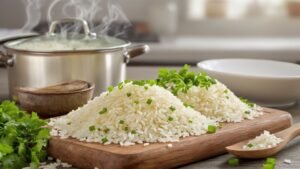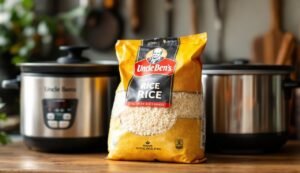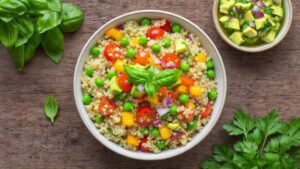Ever noticed how some rice cookers make perfect rice, while others don’t? The discussion around induction heating versus pressure cookers is often intense. Trying to decide on the best cooking method for your rice? Let’s explore these two options to help you decide.
Table of Contents
ToggleKey Takeaways
- Induction heating rice cookers offer precise temperature control for enhanced grain texture.
- Pressure rice cookers excel in reducing cooking time while preserving nutrients.
- High-end models combine both induction heating and pressure cooking for superior quality rice.
- The price of advanced rice cookers can be significantly higher, but many users find the investment worthwhile.
- Maintenance and ease of use are crucial factors when choosing between cooking appliance options.
Overview of Rice Cooking Technologies
Rice cooking has improved a lot over time. New technologies make it easier and more versatile to cook rice. I’ll show you how rice cooking has changed from the old ways to the modern rice cookers.
Traditional Rice Cooking Methods
Before, people would cook rice on a stove or in a simple electric cooker. These methods could be fast but often left the rice unevenly cooked. The bottom might be too cooked while the top wasn’t done. Cleaning was also hard because of the fixed bottom plate.
Modern Innovations in Rice Cookers
Now, we have modern rice cookers that do a lot more. They can cook all rice types perfectly. A big improvement is using induction heating. This evenly cooks the rice by heating the whole cooker. It makes the rice come out just right every time. Modern cookers are also easy to clean because they don’t have a fixed heating plate.
Here’s a table that shows how traditional rice cooking methods and modern rice cookers compare:
| Aspect | Traditional Rice Cooking Methods | Modern Innovations in Rice Cookers |
|---|---|---|
| Heat Distribution | Uneven, bottom-heavy | Even, surrounds entire cooker |
| Cooking Speed | Quick but variable results | Optimal and consistent timing |
| Cleaning | Challenging due to fixed heating plate | Easy due to detachable components |
| Versatility | Limited to basic rice types | Multiple settings for various rice types |
What is Induction Heating in Rice Cookers?
Induction heating updates how we make rice by using a magnetic field. It heats the cooking pot directly. This keeps the heat even, cooking the rice perfectly on all sides.
How Induction Heating Works
Induction heating is powered by electromagnetic induction. An electric current flows through a coil, creating a magnetic field. This heats the metal pot, cooking the rice evenly without any cold or hot spots. For instance, the Zojirushi NP-NWC10 utilizes this method for top cooking quality.
Benefits of Induction Heating
There are many advantages to using induction heat. It gives perfect rice every time. It cooks faster but still ensures the best taste. Induction tech also means less energy, saving money and the planet. And because it cooks evenly, the pot is easier to clean.
Types of Rice Dishes Best Suited for Induction Cookers
Induction cookers handle many rice dishes well. They can cook jasmine and basmati rice, as well as GABA and beans rice perfectly. With good temperature control, sticky rice, sushi rice, and brown rice also turn out great. So, these cookers are great for anyone, including chefs, who like to cook different rice dishes.
Here’s a detailed comparison:
| Feature | Traditional Cooker | Induction Cooker |
|---|---|---|
| Uniform Heat Distribution | No | Yes |
| Energy Efficient | No | Yes |
| Quick Cooking | Slow | Fast |
If you want a rice cooker that stands out in performance and versatility, go for an induction model. It’s a smart choice.
What is Pressure Cooking in Rice Cookers?
Pressure cooking in rice cookers is a new way to cook that shortens cooking time. It uses high-pressure steam to do this. This process doesn’t just make cooking faster, it keeps food’s nutrients locked in. Basically, it changes how we cook rice and grains with the help of modern tech.
Mechanism of Pressure Cooking
Here’s how pressure cooking works: it’s about the cooker creating a sealed space. When you heat it up, the water inside turns to steam. Since the steam can’t escape, it raises the pressure. This high pressure makes the water’s boiling point go higher than 100°C (212°F). In the end, your food cooks a lot quicker but still ends up perfectly done.
Advantages of Pressure Cooking
Pressure cooking has several key benefits. The first is its efficiency. It’s much quicker than regular cooking, saving both time and energy. Plus, you need less water since the pot is sealed. This keeps more nutrients in your food. Modern pressure cookers are also safer than they’ve been before. They come with lots of safety features like special lids and valves to release pressure if it gets too high.
Common Dishes Made with Pressure Cookers
Pressure cooking opens up a whole new world of dishes you can make. You can turn out everything from light, fluffy rice to rich congee. Grains like quinoa and barley come out soft in no time. This method is great for making soups, stews, and risottos as well. So, a pressure cooker is really a must-have tool for your kitchen.
Induction Heating vs. Pressure Rice Cookers
Induction and pressure rice cookers offer unique benefits. Induction cookers heat rice evenly, making perfect rice every time. Pressure cookers, on the other hand, cook rice quickly and make it tender.
Induction cookers are often easier to clean because they have fewer parts. They also control temperature precisely, resulting in a stable cooking process. Pressure cookers, known for their rapid cooking, fit well for busy individuals.
Now, let’s explore what makes each cooker special:
| Features | Induction Heating Rice Cookers | Pressure Rice Cookers |
|---|---|---|
| Cooking Time | Moderate | Fast |
| Even Cooking | Excellent | Good |
| Ease of Cleaning | High | Moderate |
| Rice Texture | Consistent | Tender |
| Temperature Control | Precise | Variable |
Choosing between induction and pressure cookers depends on what you need. If you want consistent results, go for induction heating. If saving time is key, opt for quick pressure cooking.
Pros and Cons of Induction Heating Rice Cookers
Induction heating rice cookers are a new way to cook rice precisely and with ease. Knowing their ups and downs can guide users in choosing between induction units and pressure cookers.
Strengths
These rice cookers excel at keeping the cooking quality consistent. They heat rice evenly, making sure every grain is perfectly cooked. You can make various types of rice, like sushi or brown rice. And, they’re easy to clean, a big step up from old-fashioned models.
Limitations
Induction heating cookers do have drawbacks. First, they’re usually more costly than other rice cookers. This makes them harder to afford for some people. Also, some parts can’t go in the dishwasher, increasing cleanup time. These points are important when you decide between this type and pressure cookers.
Maintenance and Durability
Generally, these cookers are very durable. But, like any appliance, they need regular care to last long. It’s key to change the gasket every few years. This step ensures your cooker works well for many years.
Pros and Cons of Pressure Rice Cookers
Pressure rice cookers are becoming popular for their quick, efficient rice cooking. They use pressure cooking advantages to improve starch digestibility and cut down cooking time. This makes them great for various dishes, turning them into a key tool for many homes.
On the downside, pressure rice cookers have their drawbacks. It’s important to weigh these against the benefits to decide if they’re right for you. Let’s dive into the details.
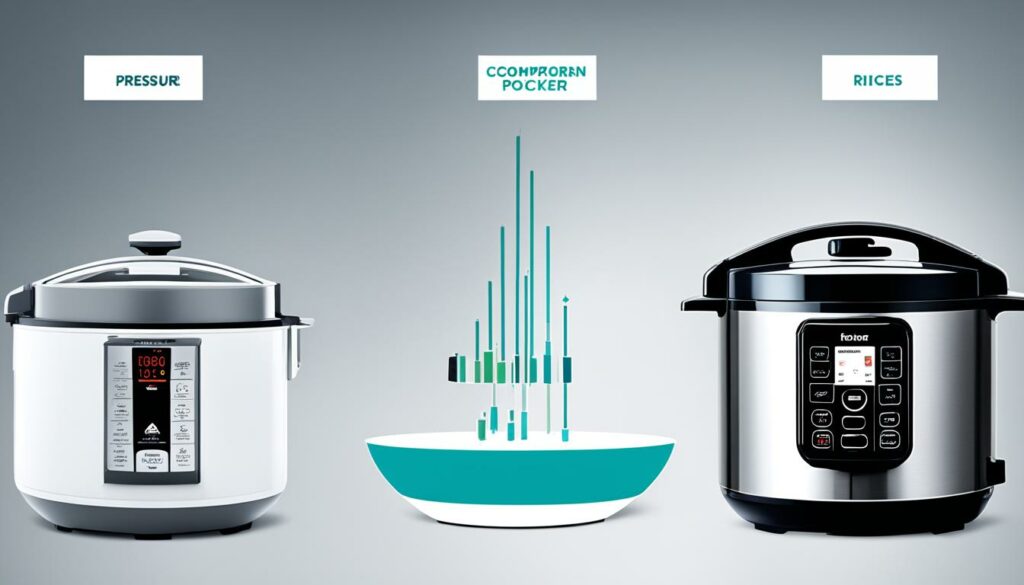
- Pros:
- Enhanced digestibility of starches.
- Rapid cooking times.
- Versatility in handling diverse recipes.
- Cons:
- Requires regular maintenance, like gasket replacements.
- Inability to add ingredients mid-cooking.
- Potential for rice crust formation, necessitating more intensive cleaning.
Compared to similar appliances, the cooking appliance comparison shows pressure rice cookers have standout benefits. Yet, they need more care for upkeep and cleaning. Rice cooker efficiency is thus countered by the effort required for its maintenance.
If you’re wondering how they fare against other rice cookers, here’s a brief breakdown:
| Aspect | Pressure Rice Cookers | Other Rice Cookers |
|---|---|---|
| Cooking Time | Fast | Moderate |
| Maintenance | High | Low |
| Versatility | High | Moderate |
| Ease of Cleaning | Moderate to Difficult | Easy |
Which Cooking Method is Best for Rice?
Choosing the right way to cook rice involves looking at a few key points. We’ll check out the good points of both induction and pressure cookers. This will help you decide wisely.
Factors to Consider
Think about what matters most when picking a way to cook rice. Induction cookers are great because they control the temperature precisely. This leads to rice cooked evenly every time. Pressure cookers, on the other hand, are fast. They often create a different, chewier texture, especially with brown rice.
User Preferences and Needs
What you like in a rice cooker makes a big difference too. Some people love all the special functions of induction cookers. They can cook different types of rice and grains perfectly. Others enjoy how quickly pressure cookers get the job done. Your pick depends on what you need and what you like in a kitchen tool.
Cost Analysis
Looking at the cost can also help you choose. Induction cookers can be quite pricey because of their high-tech features. But, they offer a lot in return. Pressure cookers, although not as expensive, are also very effective. It’s vital to think about how you cook rice. This will help you decide if the extra cost of an induction cooker is worth it. For those who cook rice often and want every grain perfect, it might be. For those who don’t, a pressure cooker could be the better choice. It’s all about what fits your lifestyle and budget.
In the end, weighing the cost and benefits is critical for making the right pick. This will ensure you choose the method that’s best for your needs.
Conclusion
After looking at induction heating and pressure rice cookers, I see the choice is really up to you. The decision depends on what you need in cooking and your budget. Each type has its own benefits, and what matters is how they fit into your life.
Induction rice cookers are great at making sure every rice grain is well-cooked. They use special technology to cook rice evenly. This makes them perfect for people who want their rice just right. Yet, they can be more expensive than other rice cookers.
Pressure rice cookers, on the other hand, are known for being fast and efficient. They cook rice quickly but still make it tender. They’re perfect for families who are always on the go. If you love making rice often, this might be the right choice for you.
To pick the best cooker for you, think about what you need for your cooking. Consider your favorite rice dishes and how often you make them. This will help you choose between these two types.
Choosing between induction heating and pressure cookers requires some thought. Consider what you need for your cooking, your everyday cooking habits, and your budget. With this in mind, you can choose the best cooker for you. Both types are big steps forward from traditional cookers and will make cooking rice a lot easier.
FAQ
What are the main differences between induction heating and pressure rice cookers?
Induction heating rice cookers have a coil that heats all around. They make sure the rice cooks evenly and are easy to clean. Pressure cookers make the rice cook faster with tender grains by using high temperature and pressure. Choose the one that fits your cooking style best.
How does induction heating work in rice cookers?
Induction heating works by surrounding the pot with a heating coil. This gives every grain of rice the same heat. It’s great for meals that need precise cooking.
What are the benefits of using an induction heating rice cooker?
These cookers evenly cook rice and are easy to clean. They work well with special types of rice, like GABA, and dishes with beans. They last long and are efficient.
How does pressure cooking work in rice cookers?
Pressure cooking keeps steam trapped to increase pressure. This makes water boil at a higher temperature, cooking the rice quickly and making it soft.
What are the advantages of pressure cooking for rice?
Pressure cooking makes rice quick to cook and soft to eat. It’s perfect for all sorts of rice, congee, and grains such as quinoa.
Which rice dishes are best suited for induction heating rice cookers?
Induction cookers are perfect for delicate rice dishes that need even cooking. They’re great for GABA rice, rice with beans, and fancy rice types.
What factors should I consider when choosing between induction heating and pressure rice cookers?
Think about the quality of cooking you want and how easy they are to care for. Also, consider your cooking needs and budget. Induction cookers cook evenly and are simple to clean but they are pricier. Pressure cookers cook fast and keep the rice tender but might need more care.
What are the pros and cons of induction heating rice cookers?
Induction cookers make rice cook evenly and are simple to clean. They are, however, costly and some parts might not be safe for dishwashers.
What are the pros and cons of pressure rice cookers?
Pressure cookers cook rice fast and make it tender. They are good for a variety of dishes. However, they might need more care and could be hard to clean.
How does the cost analysis compare between induction heating and pressure rice cookers?
Induction cookers are likely more expensive than pressure cookers. Pressure cookers offer decent quality at a lower cost. Yet, top-of-the-line induction cookers might be better for specific uses. Consider how often you cook and your needs when choosing.
Are there any safety concerns with pressure rice cookers?
The main safety issue with pressure cookers is not being able to open them while cooking. This is because of the high pressure. Always follow the safety instructions to avoid mishaps.


